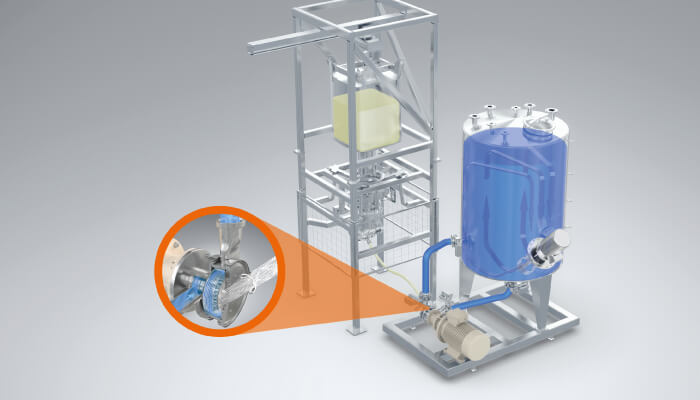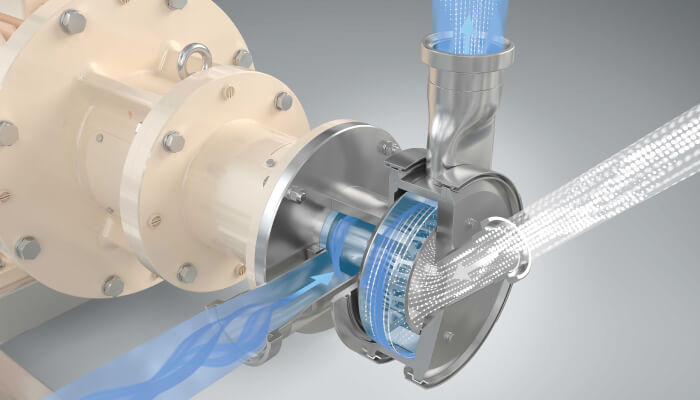This article is part of our special focus on "traditional" pharma: The Small Molecule Manufacturer (read more here). You can find more articles from The Small Manufacturer here.

In the past, no matter whether producing a coating, gel or granulated product, simple propeller stirrers were used to mix solids into a liquid. There were disadvantages associated with air intake, as well as long and non-reproducible processes, and insufficient dispersion. Some problems could even lead to system shutdown in subsequent steps, such as dosing or coating. For example, if the active ingredient volatilizes during degassing or due to non-optimal dispersion, agglomerates are still present and can interfere with other equipment, such as clogging coater nozzles.
Mixing technology has, fortunately, come a long way since then. Today, it is possible to wet and disperse the powders directly via a vacuum expansion method when inducted into the liquid. Other technologies are also available, but tend to include a long dispersion time and mechanical impact, which leads to the need to then cool the process. In my view, vacuum expansion offers numerous advantages, including better product quality and reproducibility, as well as dust-free power handling. Modern mixing systems also offer shorter production times through improved efficiency and are usually easier to clean. Many systems today are designed to be cleaned in place, for example, and have other design features that improve cleaning.

If you are looking for a simple mixing system, I recommend taking care to ensure that it has no free-rotating shaft because this can lead to the formation of a vortex and the impact of air. For more difficult applications, care should be taken to ensure that solids are not scattered from above into the vessel and onto the liquid surface, which can lead to the formation of agglomerates. It is always advisable to feed the two streams (powder and liquid) from opposite sides into a dispersing system to wet and disperse the powder under vacuum (as noted above). The actual batch tank does not have to be vacuum or pressure resistant for this purpose.
Our Conti-TDS is a powder dispensing and dispersing machine that makes it possible to remove toxic, carcinogenic, active ingredient-laden or simply difficult-to-wet powders in a dust-free and easy way. With a variety of sizes and application-specific dispersing tools, this system can cope with batch sizes from 5 liters up to several thousand cubic meters.
Put simply, the machine transports and disperses powders directly into liquids. How? By generating an extremely powerful vacuum, which reaches up to a few millibar (absolute pressure) in its dispersing zone. Powders consist of individual particles that touch one another, but there is air between these particles. The volume of air enlarges under vacuum and the distances between the particles increase. As a result, the particles are separated. The nearer the powder comes to the zone of maximum vacuum, the greater the distances between the particles. This effect can only be used in a powder flowing at high speed and under an increasing vacuum. It is precisely this effect that the Ystral Conti-TDS uses when adding powder and dispersing by vacuum. The machine transports and disperses powders directly into liquids. For this, it generates an extremely powerful vacuum in its dispersing zone so that the powder is inducted precisely into this area.
The closer the powder comes to the dispersing zone, the greater the vacuum and the faster the powder flows, which increases the distances between the individual particles. In the dispersing zone, the individual powder particles come into contact with the liquid under maximum turbulence where they are completely wetted and colloidally dispersed. Agglomerates are not created, and further dispersing is not required.
Actually, each system is tailored to the task and the local conditions on site, so we have developed a number of variations that customers can select. It is very important to work closely with customers – and I think pharma companies always find it an interesting experience to work with machine experts. We examine processes, bring in our technical know-how and are often able to exploit potential of which our customers were not aware.
Many customers don’t realize the level of care and attention that goes into building pharmaceutical manufacturing equipment. One of the biggest challenges is being able to produce equipment that can cope with both large and small batch sizes. Depending on the customer’s order requirements, engineers may need to redesign system geometries and reconsider the volume of the vessel. There is a lot of thought that goes into this. Such factors are very important to the smooth and efficient running of the machine but typically go completely unnoticed by customers!

Good quality mixing machines are typically robust and built to last, but we recommend regular maintenance and careful handling; if you look after the system then there is no reason why it shouldn’t still be producing products of the same quality after 30 years of use! That said, although equipment can be used for many years it is always good practice to evaluate new state-of-the-art technologies as they become available. In the pharmaceutical industry in particular, it is astonishing (even to me) that, because of validation and approval issues, legacy technology remains in use despite much more practical and significantly more efficient systems becoming available...

Right now, we are keeping our eyes on new applications in the market. Renewable organic raw materials is one key area. In addition, there is a lot of interest in the cannabis market. We have already carried out some initial projects in this field, but you’ll have to watch this space for further details!




